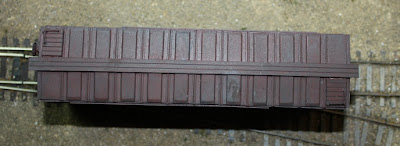But wood running boards were not required to be replaced on older cars, unless a running board repair was required. Accordingly, well into the 1950s many house cars could be seen with their old wood running boards. The topic of this post is, what did they look like? and how should our models look?
Many models, for years, have had running boards represented as though the boards extended for the full length of the car. Forty-foot planks were neither common nor cheap, even in the heyday of Western logging, so this is an improbable arrangement, but models have often been produced this way. Here is an example (I will not identify the maker):
This is an example of the three running board planks being unbroken from end to end of the car. It seems to me that the least one should do is recognize that real running boards were made up of multiple planks. Some newer models are in fact manufactured this way. Below is one end of a Broadway Limited New York Central 40-foot steel box car. Each board comprises three separate planks. (You can click to enlarge.)
At each end, plank ends are located at the third and fourth roof ribs. Measuring the three boards, all three have an approximately 11-foot plank at one end, a 14-foot plank at the other, and a 17-foot plank in the center, but the 11- and 14-foot plank locations are reversed on the center board, relative to the two outer boards, to stagger the joints. (These are nominal dimensions, depending on the exact spacing of running board supports on the roof; roughly 3 feet is common.) Car drawings in different volumes of the Car Builders Cyclopedia do not always show running board divisions, but when they do, they agree with the arrangement just described on this particular model.
Any model with running boards shown as full-length planks can be given scribed lines to indicate board ends, or even a simple pencil line will suggest the presence of a joint (located, of course, exactly at running board support positions on steel roofs). That would be the first step. Whether one chooses to try and model the bolt heads that attach the planks to the running board supports, is a personal choice, but often these heads were countersunk, so that crewmen atop a car would have a smoother walkway.
But there is more to the story. The wood planks were fully exposed to weather of all sorts, and inevitably the paint-holding ability would vary from plank to plank. That in turn would result in some planks showing more weathered or faded paint than others. Here is a portion of a prototype photo from April of 1943, taken by Jack Delano at the Galewood yard of the Milwaukee Road in Chicago, Illinois (Library of Congress photo LC-USW361-619).
Note that most of the wood running boards shown have variations in appearance, especially at the left of the nearest row of cars, and the third and fourth from the left in the second row. In fact, that first car at bottom left looks as though the boards are replacements, with cleaner paint than the remainder of the running board. Even the Alton box car at upper left, looking freshly painted, shows some variation in the darkness of color on its running board planks. But do note that almost all variations are subtle, not glaringly obvious.
(Note also some paint failure on roofs, primarily the car second from left in the upper row, and to a lesser extent on the car third from left in the bottom row. But most cars here, as in most photos from this era, show little or no failure of this kind.)
From this photo, we can suggest several patterns. First, individual planks may vary in how weathered or faded they look, though all were originally applied and painted at the same time. Second, replacement boards may be freshly painted (or even unpainted), then weathered or faded to varying degrees. And third, a plank may even be missing, though such a car would be bad-ordered upon discovery of the defect, so such cars would be rare.
How would we go about modeling these variations? There are a number of options, and that’s the topic of the next post in this series.
Tony Thompson



Tony, I enjoy your blog very much and print out pages that are of particular interest and file for future reference. I notice that starting with this blog entry, I can no longer print directly from your blog site. This is obviously a recent change and I just wondered why. I can still print the e-mail you send, but now I can no longer go back and print previous blog entries before I became a subscriber.
ReplyDeleteThanks and be well, Len Raley
Len, I don't know what has changed. I have not changed any settings from my side. Google may have made some system modification, but I don't know what it is. Best approach might be to ask THEM what has changed.
ReplyDeleteTony Thompson